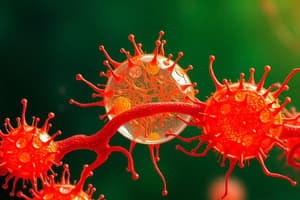Podcast
Questions and Answers
Cells combine to create ______, which consist of similar types of cells arranged together to serve a particular function.
Cells combine to create ______, which consist of similar types of cells arranged together to serve a particular function.
tissues
Organs integrate multiple ______ to accomplish a larger task.
Organs integrate multiple ______ to accomplish a larger task.
tissues
Multiple organs come together to form ______, which allow the body to achieve essential functions like reproduction, respiration, circulation, excretion, and digestion.
Multiple organs come together to form ______, which allow the body to achieve essential functions like reproduction, respiration, circulation, excretion, and digestion.
organ systems
Finally, entire organisms coordinate these ______ to adapt according to environmental conditions and maintain homeostasis.
Finally, entire organisms coordinate these ______ to adapt according to environmental conditions and maintain homeostasis.
Each cell contains specialized components called ______ that carry out specific roles for the cell's survival.
Each cell contains specialized components called ______ that carry out specific roles for the cell's survival.
Organs vary widely across species, with examples ranging from simple tubes in sea creatures to intricate digestive systems in ______.
Organs vary widely across species, with examples ranging from simple tubes in sea creatures to intricate digestive systems in ______.
Flashcards are hidden until you start studying
Study Notes
Organization of Living Organisms
Living organisms exhibit a variety of structures and functions to survive and reproduce within their environments. The organization of living organisms encompasses several aspects, including cellular structure, tissue organization, organ systems, and whole-organism function.
At the microscopic scale, cells make up multicellular life forms. Each cell contains specialized components called organelles that carry out specific roles for the cell's survival. Examples of organelles include nuclei containing genetic information, mitochondria producing energy, and chloroplasts helping plants convert sunlight into energy. Cells combine to create tissues, which consist of similar types of cells arranged together to serve a particular function. For instance, muscle tissue is made up primarily of muscle fibers designed for movement.
Organs integrate multiple tissues to accomplish a larger task. Organs vary widely across species, with examples ranging from simple tubes in sea creatures to intricate digestive systems in humans. Multiple organs come together to form organ systems, which allow the body to achieve essential functions like reproduction, respiration, circulation, excretion, and digestion. Finally, entire organisms coordinate these systems to adapt according to environmental conditions and maintain homeostasis.
In the context of biology research, understanding the organization of living organisms facilitates advancements in fields like ecology, physiology, and evolutionary biology. By studying how organisms grow, develop, reproduce, interact, and respond to their surroundings, researchers can gain insight into the mechanisms underlying life itself.
Studying That Suits You
Use AI to generate personalized quizzes and flashcards to suit your learning preferences.




